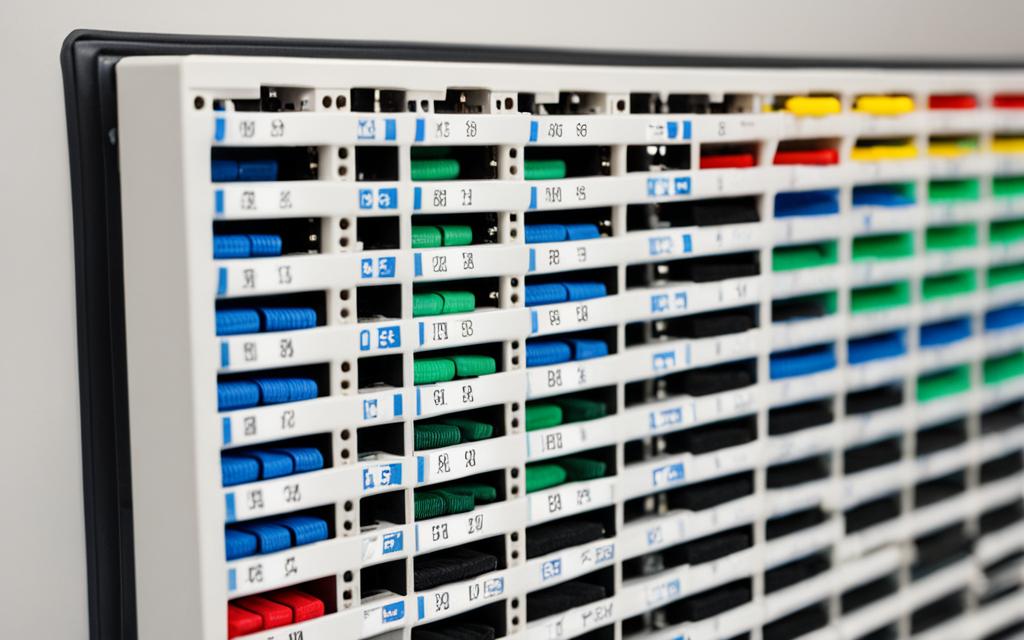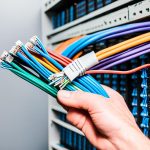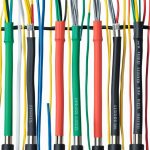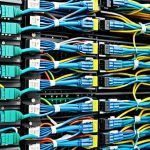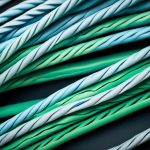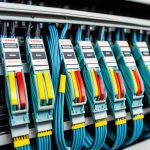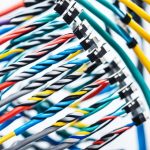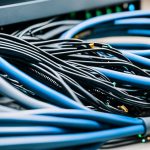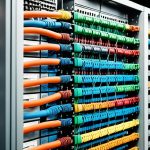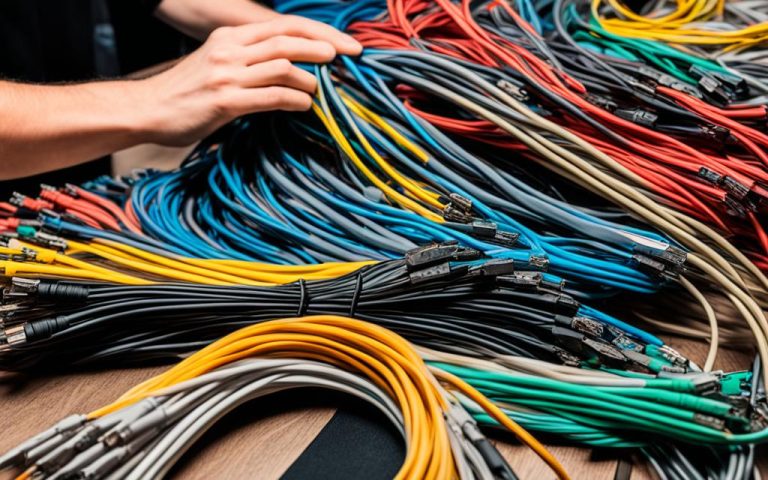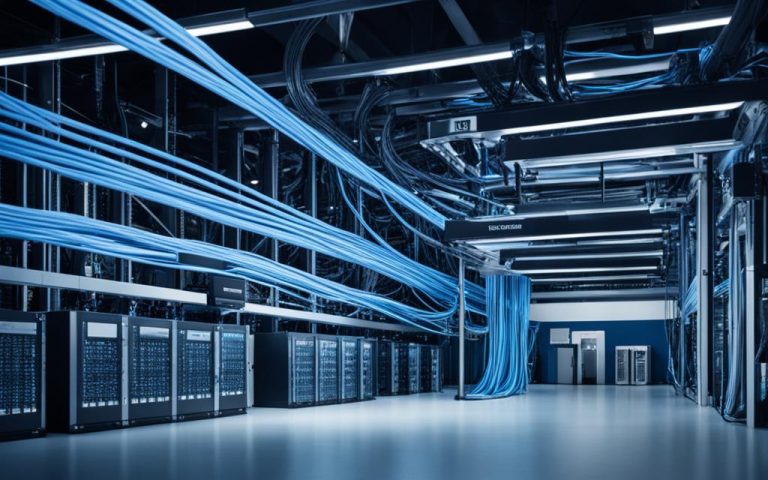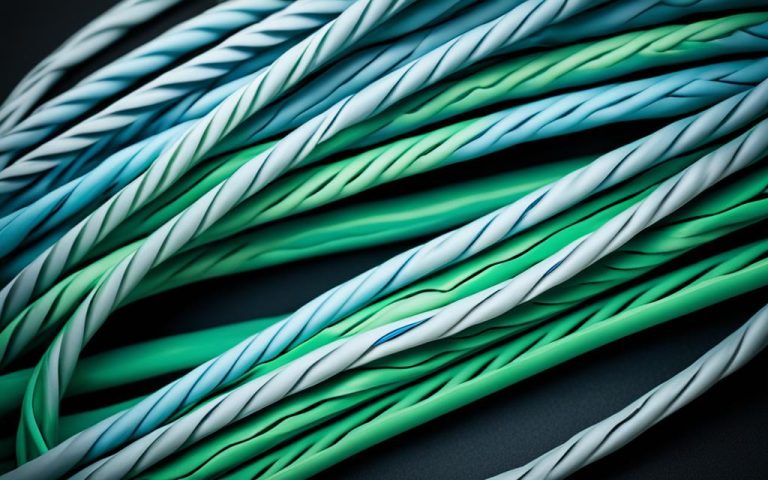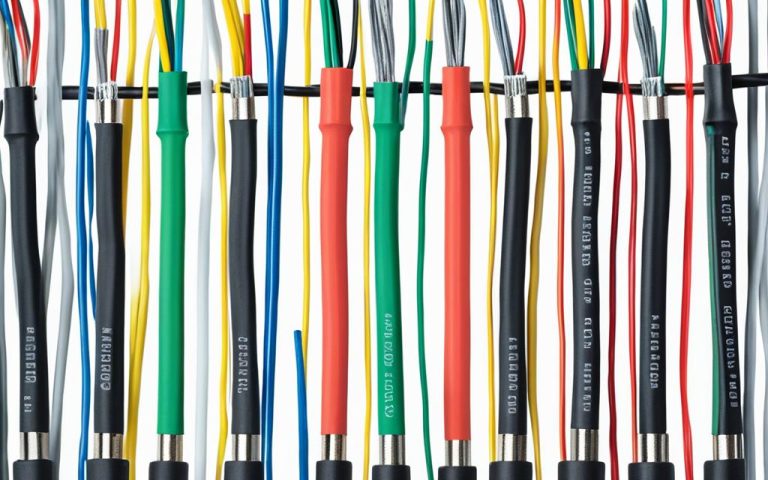Effective Twisted Pair Cable Management is crucial for maintaining a well-organized network infrastructure. Ensuring proper Network Cable Management can prevent cable clutter, reduce downtime, and simplify troubleshooting processes. One essential component for achieving efficient cable management is the use of Patch Panels in Server Racks.
Patch panels serve as the central hub for organizing cables in server racks. They provide a structured and organized approach, allowing network administrators to easily connect and route cables. By connecting incoming and outgoing lines, patch panels streamline network design, enhance performance, and facilitate troubleshooting and reconfiguration.
Understanding Patch Panels
A patch panel plays a crucial role in managing network cable infrastructure, serving as the central hub for connecting incoming and outgoing lines of servers, routers, and switches. Essentially, it acts as the nerve center of a network’s cabling system, ensuring efficient and organized connectivity.
At its core, a patch panel is a flat panel designed with multiple ports. These ports serve as the entry points for network cables to be connected, creating a central point of convergence. By connecting cables to the patch panel, administrators can easily manage and organize network connections.
It is important to differentiate between a patch panel and a switch. While they may appear similar, they serve distinct roles in network design. A patch panel primarily facilitates cable management, acting as a central connection point, whereas a switch is responsible for network traffic control and data forwarding.
“A patch panel acts as the central hub for network connections, allowing administrators to manage and organize cable infrastructure efficiently.”
To provide a visual representation, here’s an anatomy of a patch panel:
| Component | Description |
|---|---|
| Front Face | The front face of a patch panel features multiple ports where network cables are connected. |
| Back Panel | The back of the patch panel is where the convergence of cables occurs, often housing punch-down blocks or connectors to secure individual wires. |
By understanding the anatomy and functionality of patch panels, network administrators can effectively manage their network cable infrastructure and ensure seamless connectivity throughout their network.
The Anatomy of a Patch Panel
When it comes to network cable management, patch panels play a crucial role in maintaining an organized and efficient setup. Understanding the anatomy of a patch panel is essential for proper installation and cable management. Let’s take a closer look at the different components:
Front Face: Patch Panel Ports
The front face of a patch panel is where all the action happens. It consists of multiple ports where network cables are connected. These ports provide a convenient and organized way to patch cables and establish connections between various devices.
Back Side: Punch-Down Blocks or Connectors
On the back side of the patch panel, you’ll find punch-down blocks or connectors. This is where individual wires from the connected cables are securely terminated. The punch-down blocks ensure a reliable and durable connection, minimizing the risk of loose or disconnected wires.
Rack Mount Patch Panel
For streamlined network cable management, a rack mount patch panel is commonly used. This type of patch panel is designed to be installed in a server rack, saving valuable space and allowing easy access to the ports and wiring. A typical rack mount patch panel, also known as a 1U patch panel, takes up minimal space while accommodating a large number of ports.
Keystone Concept
A patch panel often incorporates the keystone concept, where individual jacks called keystones can be snapped into the patch panel. This offers flexibility and customization, allowing network administrators to easily modify or expand their network connections as needed.
Patch Panel Cable Management
Proper patch panel cable management is essential for maintaining an organized and efficient network infrastructure. Implementing cable management techniques such as cable routing, bundling, and labeling helps prevent tangling, simplifies troubleshooting, and allows for easy identification and maintenance of network connections.
In summary, a patch panel consists of the front face with multiple ports, a back side with punch-down blocks or connectors, and is typically rack-mounted. The keystone concept allows for customization, while cable management ensures a tidy and manageable network setup.
| Component | Description |
|---|---|
| Front Face | The front side of the patch panel featuring ports for network cable connections. |
| Back Side | Includes punch-down blocks or connectors where individual wires are secured. |
| Rack Mount Patch Panel | A type of patch panel designed to be installed in a server rack. |
| Keystone Concept | Allows for customization with individual jacks called keystones that can be snapped into the patch panel. |
| Patch Panel Cable Management | Essential for organizing cables and facilitating network modifications. |
Exploring Shielded Twisted Pair Cabling
Shielded Twisted Pair (STP) cables are a reliable solution for mitigating electromagnetic interference (EMI) in network installations. They offer superior protection compared to Unshielded Twisted Pair (UTP) cables, making them ideal for environments with high electrical activity and EMI concerns.
STP cables, such as Cat6, Cat7, and Cat8, provide enhanced performance and data speeds for various network applications. Let’s take a closer look:
Cat6 STP Cables
Cat6 STP cables are designed to support data speeds up to 10 Gbps. They provide reliable transmission over longer distances, making them suitable for high-performance networking requirements. With their shielding capabilities, Cat6 STP cables minimize signal degradation and interference for improved data integrity.
Cat7 STP Cables
Cat7 STP cables take EMI protection to the next level. They enhance frequency support up to 600 MHz and offer 10 Gbps speeds over 100 meters. Cat7 STP cables are ideal for demanding applications that require high bandwidth and reliable signal transmission.
Cat8 STP Cables
Cat8 STP cables are designed for data centers requiring exceptional performance. With bandwidths up to 2 GHz and data speeds of 25 or 40 Gbps, Cat8 STP cables provide the highest level of performance and EMI protection. They are suitable for environments where speed and reliability are critical.
Here’s a detailed comparison of the specifications for Cat6, Cat7, and Cat8 STP cables:
| Cable Type | Data Speed | Frequency Support | EMI Protection |
|---|---|---|---|
| Cat6 STP | Up to 10 Gbps | Up to 250 MHz | High |
| Cat7 STP | 10 Gbps | Up to 600 MHz | Very High |
| Cat8 STP | 25 or 40 Gbps | Up to 2 GHz | Extremely High |
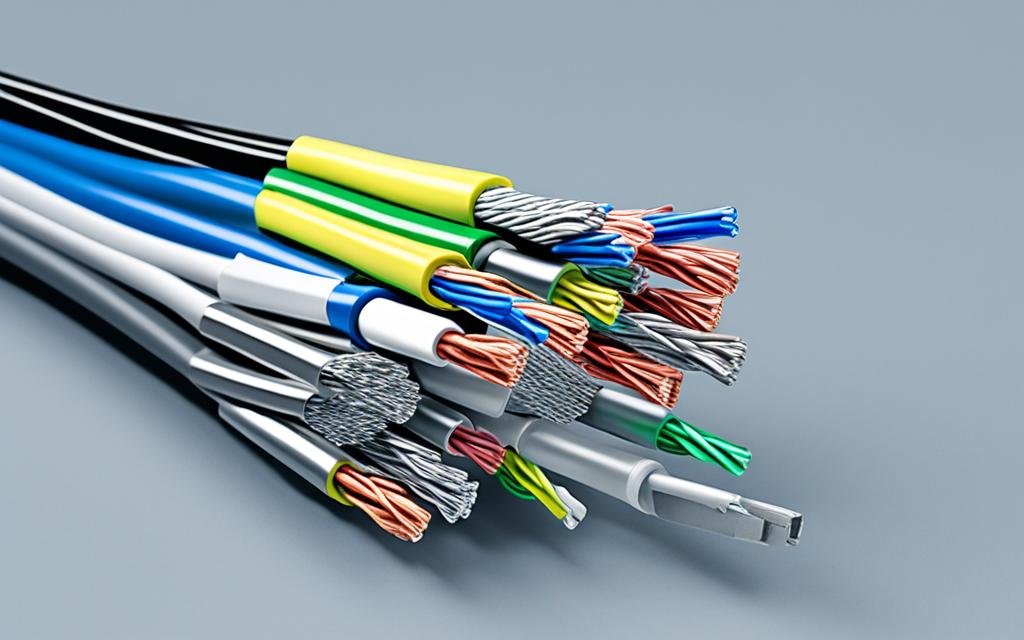
STP cables play a crucial role in maintaining signal integrity, reducing data loss, and ensuring reliable network connectivity. Their shielding capabilities protect against external interference to provide optimal performance in various network environments.
Advantages and Disadvantages of STP Cables
STP cables, also known as Shielded Twisted Pair cables, offer several advantages and disadvantages in network installations. Let’s explore the benefits and drawbacks of using STP cables for your cabling needs.
Advantages of STP Cables
One of the primary advantages of STP cables is their exceptional Electromagnetic Interference (EMI) protection. The shielding in STP cables helps to minimize interference from external electromagnetic signals, ensuring clear and reliable data transmission. This makes STP cables particularly suitable for environments with high electrical activity, such as industrial settings or areas with heavy machinery.
In addition, STP cables support high-speed data transfers, making them ideal for applications where data integrity and transmission speed are critical. These cables are capable of handling high bandwidths, providing efficient communication and reducing the risk of data loss or corruption.
STP cables also offer better resistance to crosstalk, which occurs when signals from adjacent cables interfere with each other. The shielding in STP cables helps to minimize crosstalk, ensuring clean and accurate signal transmission.
Disadvantages of STP Cables
Despite their advantages, STP cables come with a few drawbacks that must be considered. One of the main disadvantages of STP cables is their higher cost compared to Unshielded Twisted Pair (UTP) cables. The additional shielding and construction complexity make STP cables more expensive to manufacture and purchase.
STP cables are also bulkier and less flexible compared to UTP cables. This can make installation and cable management more challenging, especially in compact or crowded environments.
Another factor to consider is the compatibility of STP cables with existing network infrastructure. The use of STP cables may require additional equipment, such as shielded connectors, to ensure proper connectivity and signal integrity.
Let’s Compare
| Advantages | Disadvantages |
|---|---|
| Exceptional EMI protection | Higher cost compared to UTP cables |
| Support high-speed data transfers | Bulkier and less flexible |
| Better resistance to crosstalk | May require additional equipment |
Ultimately, the decision to use STP cables depends on the specific requirements of your network and the environment in which it operates. Careful consideration of the advantages and disadvantages can help you make an informed decision during network planning and implementation.
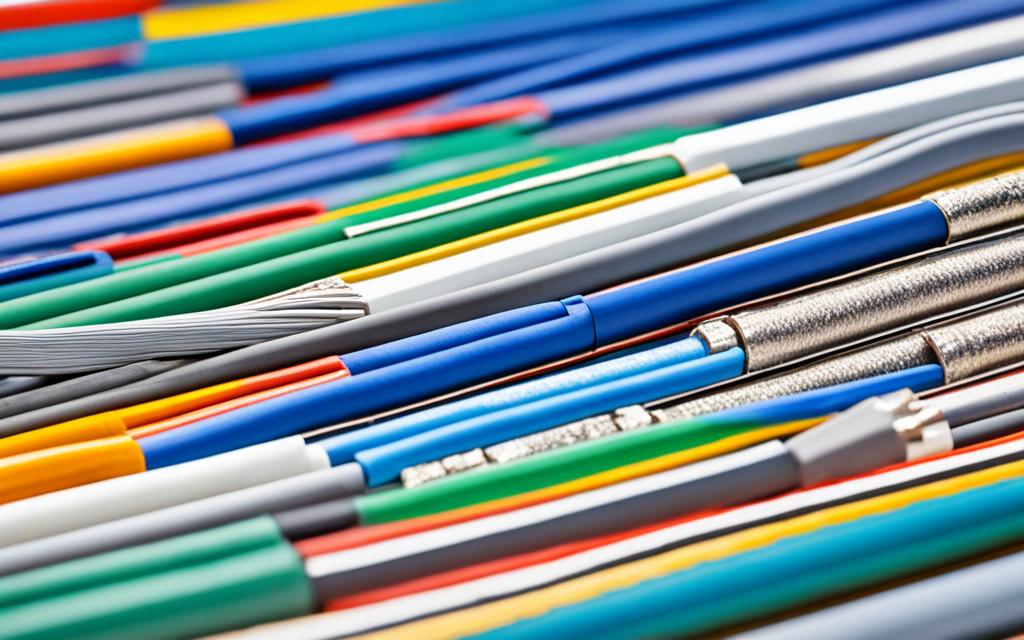
Stay tuned for the upcoming sections where we will explore the applications of STP cables and their role in providing electromagnetic interference protection in various industries and settings.
Applications of STP Cables
STP cables, known for their exceptional electromagnetic interference (EMI) protection, find extensive use across various industries and settings. Their ability to shield against external electromagnetic waves makes them particularly suitable in environments where EMI is a concern. Let’s explore some of the applications of STP cables:
1. Telecommunications
STP cables play a vital role in enabling clear voice communications in the telecommunications industry. By minimizing EMI, STP cables ensure uninterrupted transmission of voice signals, resulting in superior call quality and enhanced user experience.
2. Security Systems
Security systems heavily rely on uninterrupted video signals for effective surveillance and monitoring. STP cables provide the necessary shielding to prevent EMI interference, ensuring the transmission of smooth and high-quality video feeds for enhanced security and surveillance.
3. Industrial Automation
In industrial automation, where reliable data transmission is critical for seamless operation, STP cables deliver robust performance. These cables offer EMI protection, enabling the transfer of accurate and uninterrupted data signals between various industrial automation components, resulting in efficient workflows and increased productivity.
4. Military Applications
Military operations require secure and uninterrupted communication channels for optimal coordination and operational effectiveness. STP cables, with their superior EMI protection, are well-suited for military applications, providing reliable and secure transmission of critical information in challenging and high-intensity environments.
As demonstrated, STP cables find wide-ranging applications in telecommunications, security systems, industrial automation, and military operations, where reliable data transmission and EMI protection are paramount. The use of STP cables in these industries ensures enhanced performance, efficiency, and operational effectiveness, contributing to the overall success of these sectors.
STP Cables and Electromagnetic Interference (EMI) Protection
STP cables are the ideal solution for environments that are prone to electromagnetic interference (EMI). These cables are designed to shield against external electromagnetic waves, ensuring the integrity and reliability of signal transmission in critical network infrastructures.
Electromagnetic interference, or EMI, can disrupt and degrade signal quality, leading to poor network performance and compromised data integrity. STP cables effectively counteract the effects of EMI, providing a secure and uninterrupted signal transmission pathway free from external disturbances.
By incorporating advanced shielding technology, STP cables prevent electromagnetic waves from interfering with the signal, resulting in clear and unaffected data transmission. This level of EMI protection is crucial in high-stakes environments where signal integrity is paramount, such as data centers, telecommunications networks, and industrial automation systems.
In the words of John Shaw, a network engineer at XYZ Corporation, “STP cables have proven to be essential for maintaining signal integrity in our high-EMI manufacturing facility. We have noticed a significant improvement in network performance and reliability since implementing STP cables.”
STP cables’ ability to resist EMI makes them a reliable choice for critical applications that require seamless and uninterrupted signal transmission. These cables provide a robust and stable connection that ensures the integrity of data in even the most demanding environments.
Data centers and server rooms:
- Protection against electromagnetic interference is crucial in data centers and server rooms, where large concentrations of networking equipment and electrical currents can generate significant electromagnetic waves. STP cables guarantee unimpeded signal transmission, safeguarding critical data and ensuring the smooth operation of data center infrastructures.
Telecommunications networks:
- Clear voice communication is essential in telecommunications networks, and STP cables play a vital role in minimizing electromagnetic interference. These cables ensure that voice signals remain crisp and distortion-free, allowing for effective communication and uninterrupted service.
Industrial automation systems:
- Industrial environments often expose networking systems to high levels of electrical noise and interference. STP cables offer reliable signal transmission, enabling seamless communication between various industrial automation components and reducing the risk of data corruption or loss.
Military applications:
- In military operations, reliable and secure communication is of utmost importance. STP cables’ EMI protection makes them an ideal choice for military applications, ensuring signal integrity and minimizing the risk of interference, even in challenging and hostile environments.
With their exceptional EMI protection capabilities, STP cables serve as a critical component in maintaining signal integrity and transmission reliability in various industries and applications. By mitigating the impact of external electromagnetic waves, STP cables provide a secure and uninterrupted signal pathway, ensuring the integrity and performance of critical network infrastructures.
Conclusion
Effective cable management is the foundation of a reliable and well-organized network infrastructure. By implementing proper cabling coordination strategies, such as utilizing patch panels and shielded twisted pair (STP) cables, businesses can ensure optimal system performance, reduce downtime, and simplify troubleshooting and maintenance processes.
Patch panels serve as the central hub for organizing and connecting network cables in server racks. They simplify network design and facilitate efficient network modifications, making it easier for network administrators to manage and maintain their infrastructure. With clearly labeled ports and organized cable management, patch panels enhance the overall reliability and functionality of a network.
In addition, the use of STP cables provides crucial electromagnetic interference (EMI) protection, ensuring uninterrupted signal transmission and reliable data integrity. Suitable for various industries and settings, STP cables excel in environments with high electrical activity, making them ideal for telecommunications, security systems, industrial automation, and military applications.
By prioritizing effective cable management, businesses can create a reliable network infrastructure that supports their operations and growth. With a well-coordinated cabling system, organizations can optimize their network performance, reduce the risk of downtime, and simplify troubleshooting, ultimately leading to increased productivity and customer satisfaction.
FAQ
What is the purpose of a patch panel?
A patch panel serves as the nerve center of a network’s cabling system, connecting incoming and outgoing lines of servers, routers, and switches. It simplifies network design, facilitates troubleshooting and reconfiguration, and enhances performance in data centers and rack-to-rack cable management.
How does a patch panel differ from a switch?
A patch panel and a switch have distinct roles in network design. A patch panel serves as a central connection point for cables, while a switch functions as a networking device that directs data packets to different devices on a network.
What are the components of a patch panel?
A patch panel consists of a front face with multiple ports where network cables are connected. On the back of the patch panel, there are punch-down blocks or connectors where individual wires are secured. Additionally, there are rack mount patch panels and keystone options for customization.
What is the difference between STP and UTP cables?
Shielded Twisted Pair (STP) cables offer superior protection against electromagnetic interference (EMI) compared to Unshielded Twisted Pair (UTP) cables. STP cables are more suitable for environments with high electrical activity, while UTP cables are more cost-effective and flexible.
What are the advantages of STP cables?
STP cables provide exceptional EMI protection, ensuring clear and unaffected data signals. They support high-speed data transfers, data integrity, and are suitable for industries and settings where EMI is a concern, such as telecommunications, security systems, industrial automation, and military applications.
What are the disadvantages of STP cables?
STP cables are more expensive, bulkier, and less flexible compared to UTP cables. They require careful planning and implementation during network setup.
How do STP cables protect against EMI?
STP cables shield against external electromagnetic waves, mitigating EMI. This shielding ensures reliable signal transmission and integrity in critical network infrastructures.
Why is effective cable management important for network infrastructure?
Effective cable management, including the use of patch panels and structured cabling, enhances system performance, reduces downtime, simplifies troubleshooting, and promotes a well-organized network infrastructure.

